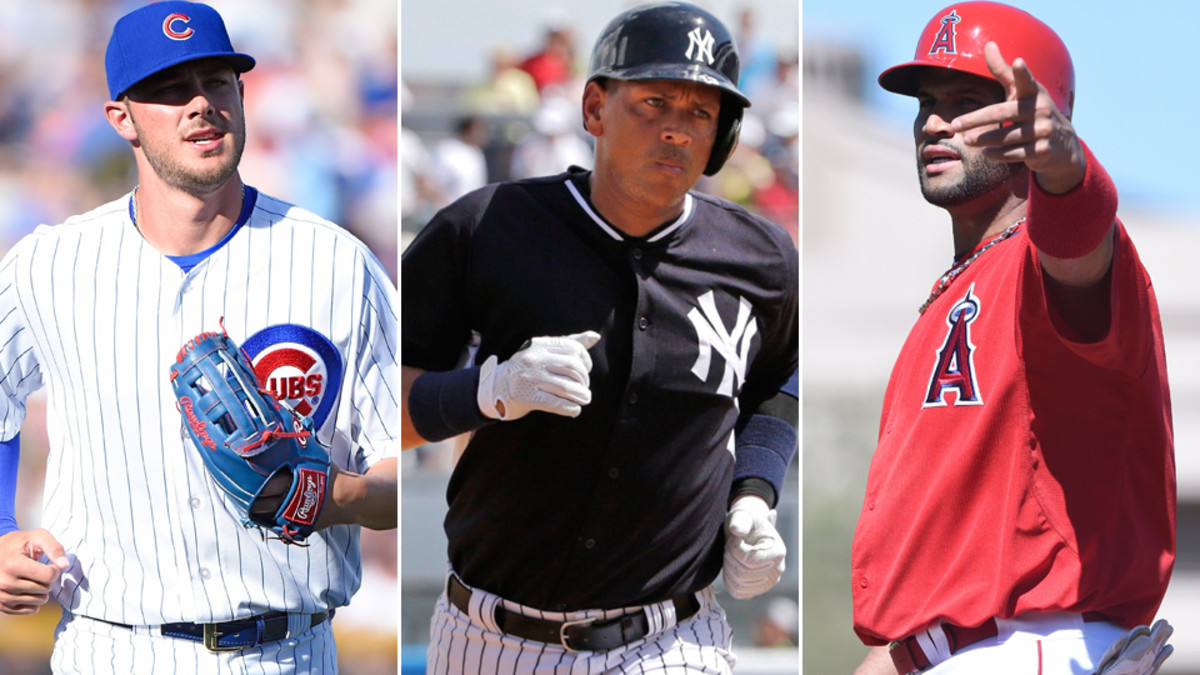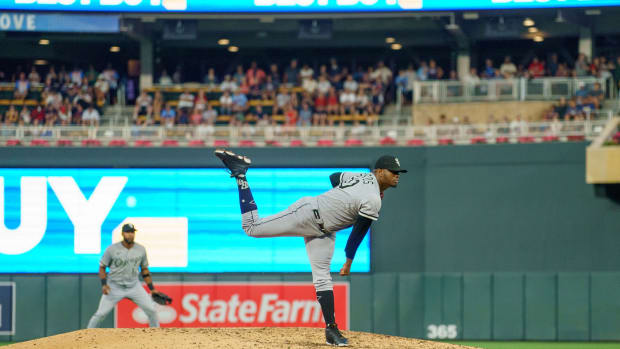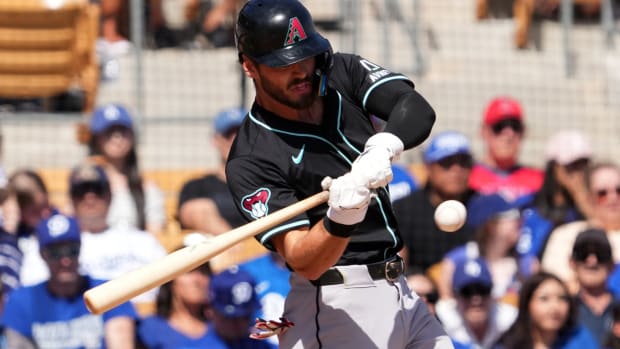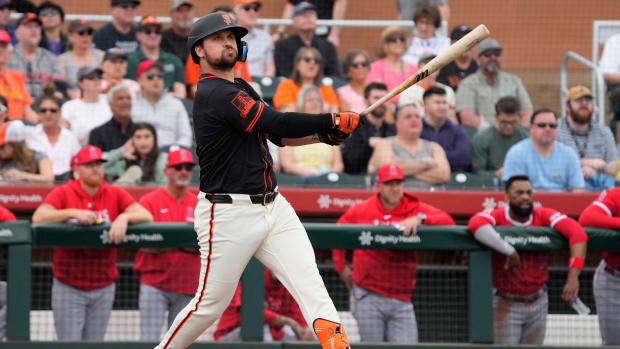
Wrapping up a long spring training with its 10 biggest storylines
After an interminable spring training, Opening Day at last is right around the corner—perhaps the last one quite like it. Next year, Major League Baseball wants to explore the right to flex to a one-game “series” for the Opening Sunday Night game—this year, for instance, it should have been Clayton Kershaw of the Dodgers going up against Madison Bumgarner of the Giants, not Cubs-Cardinals—and to stage most openers on that same Sunday afternoon, rather than getting lost amid the hype of the NCAA men’s basketball championship game on that Monday. (There are three opening games actually scheduled for when the title game is in progress. Why?)
What we do know is that spring training is too long, unless you ask the many sun-starved fans in Arizona and Florida who can’t get enough of non-roster guys with numbers in the 90s playing split-squad games. Hey, it’s still baseball, so it’s all good.
So what exactly happened for the past seven weeks to get us ready for Opening Day? Here’s everything you need to know.
• Previewing and ranking each team ahead of the 2015 season
1. Shed No Tears For Kris Bryant
Felix Hernandez threw 1,111 changeups last year on two-strike counts, and batters hit .113 against those pitches, including only six home runs. His changeup is on the short list of the best singular pitches in baseball. Now you can appreciate what Bryant did to the King in hitting a 2-and-2 changeup for a home run.
Yes, Bryant may be ready for the big leagues, but he has no business being on the Opening Day roster. The Cubs gain an extra year of control of Bryant just by keeping him in Triple A for 12 days. They would be reckless to consider 12 days this April as more valuable than his entire age-29 season in 2021. It’s not about some Joe High School complaint about “wanting to win” or “putting the best team on the field.” It’s about simple, efficient business logic under the current rules of the game.
Don't blame Cubs for taking advantage of rules with Kris Bryant
What would be the downside to carrying Bryant? The Braves traded 12 days in 2010 for Jason Heyward’s entire age-25 and age-26 seasons. (They traded him last winter in advance of his walk year.) The Marlins carried Jose Fernandez on their '13 Opening Day roster even though they were a non-contender (they would go on to lose 100 games) and even though he never was going to pitch a full season anyway (they shut him down with three weeks left due to an innings limits). Fernandez blew out his elbow the next year and won’t be back this year until midseason. So next year, Fernandez already will be just three years away from free agency despite giving Miami only about 50 career starts.
You don’t have to like the rule, in which a full service year equals 172 days. (The baseball calendar covers 183 days, thus the 12-day gap of control.) But as long as the rule is there, it makes no sense to think 12 days in April are worth giving up an entire season of a young star’s prime.
• CORCORAN: Will these 2014 breakouts regress or improve in '15?
2. Alex Rodriguez Is Back
The most overhyped part-time designated hitter in history made it through spring training in one piece. He can’t run and he can’t play defense, but in the controlled environment of spring training, he held up well for six weeks. But that controlled environment—carefully scheduled days off, playing partial games, facing minor league pitchers, etc.—reveals almost nothing about how a 39-year-old player who has played 44 games in the past two years will hold up over a six-month season.
You don’t think steroid testing has changed the baseball actuarial tables? Check this out: Over the past four seasons, here are the biggest home run seasons by any righthanded hitter as old as Rodriguez (actually, it’s the entire list):
player | year | homers |
Henry Blanco | 2011 | 8 |
2014 | 4 | |
Henry Blanco | 2013 | 3 |
Miguel Tejada | 2013 | 3 |
Ivan Rodriguez | 2011 | 2 |
Derek Jeter | 2013 | 1 |
Henry Blanco | 2012 | 1 |
By the way, only one lefthanded hitter that old has hit more than 18 home runs in any of the past four years: Raul Ibanez.
3. Albert Pujols Is Back, Too
One day in Tempe, Ariz., I was standing behind the batting cage with Angels hitting coach Don Baylor when Albert Pujols put on a spectacular show. He must have hit seven of 10 batting practice pitches far up the berm in leftfield at Tempe Diablo Stadium.
“We didn’t see that this time last year,” Baylor said. “Nothing like this. Easy power. big power. He couldn’t do that this time last year. The difference is night and day.”
Pujols, still recovering from a painful foot injury last year, bounced back with a solid season (.272/.324/.466), but with a full off-season of normal training, he has been smashing the baseball with more authority this spring.
• Sports Illustrated's World Series pick: Who will win it all in 2015?
4. The Best 18-Year-Old In Baseball
Lefthander Julio Urias, who doesn’t turn 19 until August, is far down the list of options for the Dodgers when they inevitably need help in the back of the rotation (behind Hyun-jin Ryu, who already is injured, and Brandon McCarthy and Brett Anderson). Los Angeles has Joe Wieland, Mike Bolsinger, Chad Gaudin, etc. But it has nobody like Urias, a prodigy when it comes to knowing how to pitch.
National League's biggest questions and battles before season starts
“This is going to test [team president] Andrew Friedman,” said one Dodgers source. “You know Andrew wants to be conservative with him.” In Tampa Bay, Friedman preferred leaving pitching prospects through one level per year, routinely getting 400 or so innings on their arms before moving them to the big leagues. Said another team source, “With [Urias], there are no comps about how to proceed. Maybe you go all the way back to Dwight Gooden. But this is a special case. He’s unique.”
Urias hasn’t pitched above A ball, but he has averaged 11.2 strikeouts per nine innings in his 142 professional innings. The Dodgers are likely to start him this season in Double A and prefer to leave him in the minors all year under an innings limit. But Urias may be the best lefthanded pitching prospect in all of baseball, and with poise, command and stuff well beyond his years, he has a shot—okay, a longshot at that—at becoming the first 18-year-old in the bigs since Jose Rijo in 1984.
• JAFFE: Five managers who are on the hot seat for this season
5. “Running Up the Pitch Count” Is Officially Dead
If the walk rate has hit the second-lowest point in the past 92 years (behind only 1968) and if relief pitching is far tougher to hit than starting pitching—and never tougher to hit in the past 100 years—why would anybody still concede strikes just to “see more pitches” and “get into the bullpen”? It’s an outdated, dumb approach.
Need more proof? Last year, major league teams swung at 72.5% of all strikes. Now let’s divide the teams into two groups: teams that swung at a below-average percentage of strikes (Passive Teams, of which there were 17) and teams that swung at an above-average percentage of strikes (Aggressive Teams, of which there were 13). Now let’s see how those teams measured up in the playoffs:
| postseason series won | postseason record | Winning percentage |
Passive Teams | 0 | 1–8 | .111 |
Aggressive Teams | 9 | 31–24 | .564 |
Increasingly, the correlation between seeing more pitches and winning baseball is an inverse one. Eight of the top nine teams last year in most pitches per plate appearance did not make the playoffs. Three of the nine teams who saw the fewest pitches did make the playoffs, including both pennant winners (San Francisco and Kansas City).
6. Shifting Fortunes
The bronze commemorative plaque has been ordered for Surprise Stadium: Prince Fielder bunted for a hit against the shift for the first time in his life. Expect to see more such tactics—not often, but just enough to take a free hit every once in a while. Look at it this way. Last year, Chris Davis of Baltimore batted .181 when he put the ball in play to the pull field (into the shift). On bunt attempts, he should be able to bat .600, getting three singles for every five tries. Why not?
7. Pete Rose Applied For Reinstatement
I asked Rose a few weeks ago what he thought about the new commissioner, Rob Manfred.
“Never met the man,” Rose said. “I have heard good things about him, but I don’t know him at all.”
Rose's chances at reinstatement or Hall of Fame look very slim
Rose may be encouraged simply because Manfred is not Bud Selig, but his chances of being reinstated are little better today than they were a year ago, or 26 years ago. The office of commissioner may have changed, but nothing about Rose’s situation has changed. He agreed in 1989 to be placed on the permanently ineligible list, the well-known and well-publicized penalty for betting on major league games involving your club. Since then, people continue to confuse his official status in baseball with whether he should be enshrined in the Baseball Hall of Fame. Rose has a better shot at the Hall: slim, rather than none.
Remember, in 1991, a special 10-man committee chosen by the Hall of Fame's Board of Directors changed the rules of eligibility specifically to keep Rose out. Rose was just out of jail and was one year away from appearing on the writers’ ballot when the committee voted 7-3 to decide on a new rule that “Persons on the ineligible list cannot be eligible candidates.” (Joe Jackson, also on the ineligible list, at least had his day on the ballot; he appeared on the 1936 ballot, but received only two votes.)
The vote to keep Rose off the ballot seemed so punitive that it stood in opposition to the wishes of Bart Giamatti, the late commissioner who drummed him out of the game in the first place. At the news conference to announce Rose’s ban, Giamatti was asked whether the expulsion of Rose would have a bearing on his Hall of Fame candidacy. Giamatti said he saw no need to intervene in that matter, telling the baseball writers in the room, “You will decide whether he belongs in the Hall of Fame”—except they never got the chance.
So that’s the real question: Does Rose, as Giamatti intended and as Jackson experienced, deserve at least the chance to be voted on, either by writers or by one of the Hall’s 16-member special committees, for enshrinement in the Hall of Fame? That decision belongs to the Hall, not Manfred. There has been no indication the Hall will review its rule.
8. All-Cactus, All-Grapefruit Players
You can get fooled very easily by spring training stats, but these have been the most impressive young hitters in the Cactus and Grapefruit Leagues: Addison Russell, 21, Chicago Cubs; Rougned Odor, 21, Texas; Mookie Betts, 22, Boston; Dalton Pompey, 22, Toronto; Joc Pederson, 22, Los Angeles Dodgers; Bryant, 23, Chicago Cubs; Mike Trout, 23, Los Angeles Angels; Andrelton Simmons, 25, Atlanta; C.J. Cron, 25, Los Angeles Angels; Jose Abreu, 28, Chicago White Sox; and Desmond Jennings, 28, Tampa Bay.
And here are the top young pitching performers: Eduardo Rodriguez, 21, Boston; Daniel Norris, 21, Toronto; Taijuan Walker, 22, Seattle; Michael Wacha, 23, St. Louis; Michael Pineda, 26, New York Yankees; Matt Harvey, 26, New York Mets; Arquimedes Caminero, 27, Pittsburgh; Tyson Ross, 27, San Diego; and Nick Hagadone, 29, Cleveland.
• JAFFE: Biggest spring questions, battles still unresolved in AL
9. The Pirates’ Bullpen Game Of “Survivor”
Caminero is what spring training is all about: A season that goes on far too long gives you the occasional who-the-heck-is-this-guy? story to make it worthwhile. Caminero’s full name is Arquimedes Euclides Caminero. His father, a construction worker in the Dominican Republic, decided upon the names while leafing through a math textbook. The Marlins signed Caminero in 2005, one month before he turned 18. He spent nine years in the Marlins’ system, averaging 11 punchouts per nine innings in the minors but getting just 19 major league relief appearances over the past two years, occasionally hitting 100 mph with his fastball.
Dodgers among teams hoping new system can help prevent injuries
Two weeks before camp opened this year, the Pirates purchased Caminero from the Marlins. He reported to Bradenton for a mechanical tuneup with pitching coach Ray Searage, the guru of pitching makeovers, and the results have been spectacular: 16 strikeouts, one walk and two runs in 10 1/3 innings. Caminero has a decent chance of making the Opening Day roster because he is out of options, meaning Pittsburgh could lose him through waivers if it tries to send him to Triple A.
Caminero is one of several candidates with low profiles but fascinating names competing for a spot in the Pittsburgh bullpen. In the mix with Caminero are John Holdzkom, 27, a 6'7" righthander the Pirates found in independent ball last year; Stolmy Pimentel, 25; and Radhames Liz, 31. Yes, Arquimedes, spring training is a numbers game.
10. Injuries
Most teams simply want to get through spring training with nobody getting hurt. Here are the 10 most impactful injuries of spring training.
1. Yu Darvish, Rangers (elbow). Gone for the season after Tommy John surgery.
2. Marcus Stroman, Blue Jays (knee). The 23-year-old is out for the season, testing the depth of an already thin pitching staff.
3. Christian Vazquez, Red Sox (elbow). Boston will miss one of the best defensive impact players in the game.
4. Josh Hamilton, Angels (shoulder, drug policy violation). Hamilton may be unreliable because of various injuries in recent years, but he still is a potential impact bat who is lost indefinitely.
5. Matt Wieters, Orioles (elbow). Wieters went 0-for-23 before he was shut down with soreness in his surgically repaired elbow. He will begin the season on the DL and probably play in extended spring training.
6. Hyun-jin Ryu, Dodgers (shoulder). The lefthander was shut down with a recurrence of shoulder soreness that plagued him last year, a bad sign for a club with limited starting pitching depth.
7. Zack Wheeler, Mets (elbow). The Mets were 15-17 in Wheeler’s starts last year. Dillon Gee is a capable replacement.
8. Cliff Lee, Phillies (elbow). A possible trade chip now may be looking at the end of his career.
9. Hunter Pence, Giants (broken left forearm). He could be back by the end of April, but 25–30 games without Pence is a test for San Francisco.
10. Drew Smyly, Rays (shoulder). A bout of shoulder tendinitis put Smyly a month behind schedule and bears watching. He recently resumed throwing bullpen sessions.



































